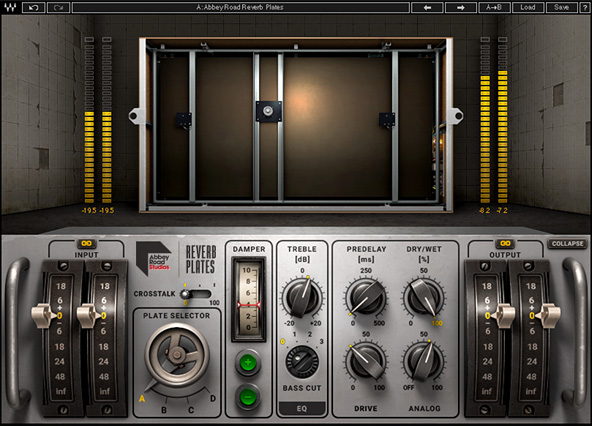On one side is the real EMT 140 plate reverb unit: a 600-pound, 8′ x 4′ behemoth introduced in 1957 as one of the first kinds of artificial reverb. On the other is a wide variety of plate reverb plugins aiming to replicate the sound and feel of the OG hardware—no easy task due to the rich, complex, colorful reverb the real deal is known for.
But is there even a contest anymore?
The truth is, the size, weight, and rarity of original EMT 140s are all factors prohibiting the average engineer from owning one. Plate reverb plugins, and plugins in general for that matter, are cheap and convenient—there’s no way around that. You can own a dozen different EMT 140 plugins. The same can’t be said for the units themselves.
The cost of a real EMT 140 is another factor, though it’s not as out-of-line as you’d think. On the low end, this one sold in London just over a year ago for around $2000, while this one in California went for $6000. There seems to be quite a bit of discrepancy here, making it hard to pin down an average price. This is more than likely due to location and the associated supply and demand. Local pickup only!
Unless you had the privilege of coming up in a legacy studio which houses some of these beasts, the majority of younger engineers will probably never even see a plate reverb unit in real life, let alone use one on recordings.
In modern recording, plate reverb plugins are really all we know. Whether they hold true to the real thing is up for debate, but they certainly do well enough to lead us into the convenient future of in-the-box recording and mixing.
And now, a brief history lesson.
The History of Plate and How It Works
Plate reverb was one of the first types of synthetic reverb to be developed. It worked by suspending a literal steel plate under tension with springs at the corners, and then attaching that plate to an outer shell. The plate would vibrate after receiving a signal from a transducer (an input signal), and that vibration would subsequently be picked up by another microphone in the unit (output signal). If you tap on any metal item large enough, you can understand the thought process behind it.
Plates were very popular when they were first developed, due in large part to being much less expensive and more practical than a dedicated echo chamber. It’s sort of funny to think there was a time when a giant 600-pound box was the “practical” alternative!
They weren’t small by any means, but were less invasive than an echo chamber, no doubt. Plate wasn’t the only type of synthetic reverb at the time, though. Spring reverb was also used frequently, though plate tended to dominate up until digital reverb was developed.
The thing is, both spring and plate reverb sounded really bizarre compared to natural reverb in a space, but it was used so often after it was developed that it became a sound we readily associate with recorded reverb.
When digital reverbs came out they sounded even less natural than plate or spring, but they were again a more practical alternative. I’m seeing a theme here…
Of course nowadays, with so much mixing done entirely in-the-box, plate reverb plugins rule today’s recording world, and they sound incredible. Beyond plate, we have the ability to replicate any sonic space imaginable with any of the many, many, fantastic reverb plugins on the market.
Plate plugins dominate. Here’s a few ways to use them:
For Color
Plate reverbs are great for adding perceived brightness to an instrument. If you’re wondering how, it’s because you can use plate reverb to take advantage of a psychoacoustic phenomenon called the precedence effect. The precedence effect basically means that we hear higher frequencies before we hear lower ones.
So if you add a plate to a vocal and leave the full frequency spectrum in, your ear will perceive those reverberated highs first. This will make the vocal appear brighter than it actually is.
As an Effect
Our ears are adept at determining whether a sound is natural. Because of this, we instinctively know whether a reverb is coming from an actual physical space, or some place unnatural. Plate reverb is synthetic, and our ear knows this, but that’s okay because plates can be used as an effect.
Mixing music isn’t always about realism! Depending on the material, sometimes the most outlandish and unusual sounds are the perfect fit for the track. Consider using plates when you aren’t concerned with creating a space that sounds ‘real.’
To Blend with Other Reverbs
It’s very common to use multiple reverbs while mixing. If you mix from a template, for instance, you might already have chamber, hall, room, and plates set up and ready to go, adding a bit of each to taste as you mix.
Plates are great to blend with other reverbs, because they have a different quality from a dedicated space. On a totally dry track, you can pick a space, like a room or hall, and then augment that with plate instead of another room. This ensures you won’t be creating a ‘room within a room’ vibe.
Think about it on drums. If they were recorded in a live space, you’ll have natural reverb already printed. Rather than adding a ‘drum room’ reverb emulation to a real drum room, you can mix in some plate instead.
RELATED:
Real Plate Reverb in the 21st Century
For what it’s worth, if you do a little bit of digging, you can find companies who are currently producing plate reverb units on a made-to-order basis.
CVRSE (Classic Vintage Recording Studio & Engineering) is one of these companies, and they’re currently accepting preorders for a batch set to release at the end of the year. At $2900, you’ll have to decide just how much you hate your plugins…
